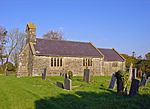Coedmor National Nature Reserve
Coedmor National Nature Reserve is a nature reserve in Wales, located just south of Cardigan, between Llechryd Bridge and the Teifi Marshes in Ceredigion. It was established in order to protect the natural oak woodland on the slopes on either sides of the Teifi gorge. With Cilgerran Castle standing dramatically above wooded slopes, the area has attracted painters such as Turner and Richard Wilson, amongst other travellers and writers. The gently flowing River Teifi and its banks are a habitat for otters, and for the rare club-tailed dragonfly. Beside the dominant oaks, other broadleaved tree species include lime, ash, wych elm, holly, spindle and hazel. Nearly 200 species of lichens have been recorded as being present in the woodland and 31 species of butterflies have been recorded from the reserve or the area around it.
Excerpt from the Wikipedia article Coedmor National Nature Reserve (License: CC BY-SA 3.0, Authors).Coedmor National Nature Reserve
Church Street,
Geographical coordinates (GPS) Address Nearby Places Show on map
Geographical coordinates (GPS)
| Latitude | Longitude |
|---|---|
| N 52.0613 ° | E -4.6328 ° |
Address
Church Street
SA43 2SU , Cilgerran
Wales, United Kingdom
Open on Google Maps









